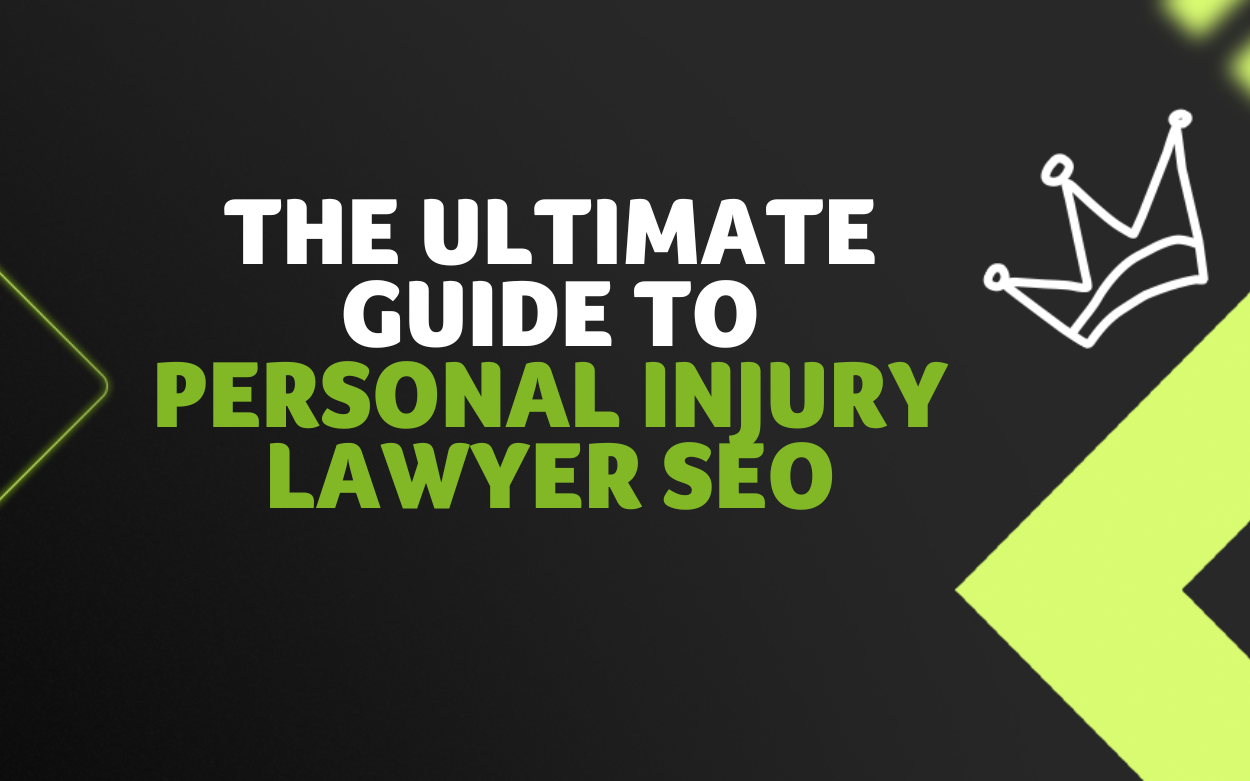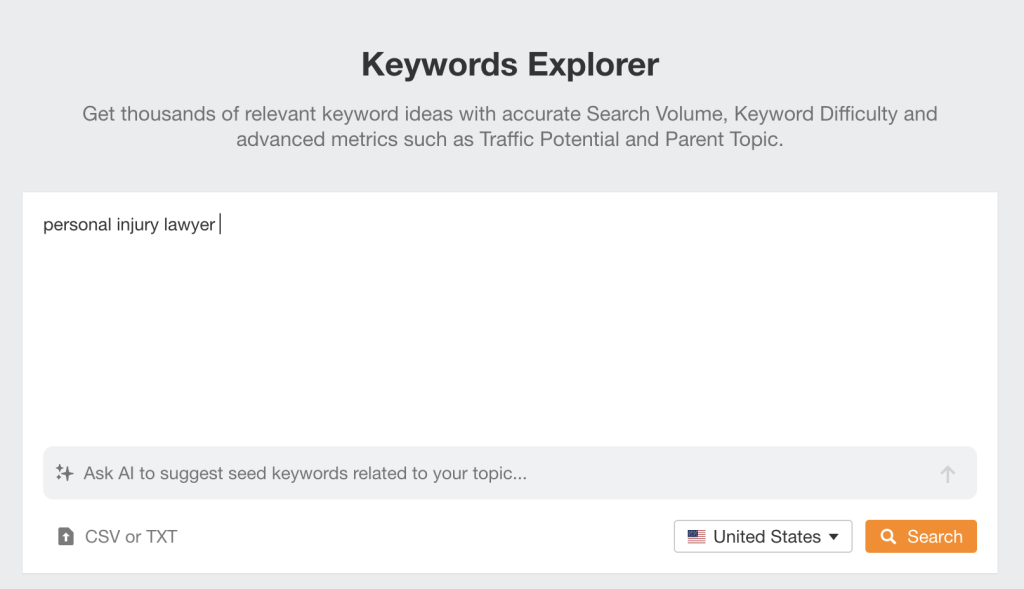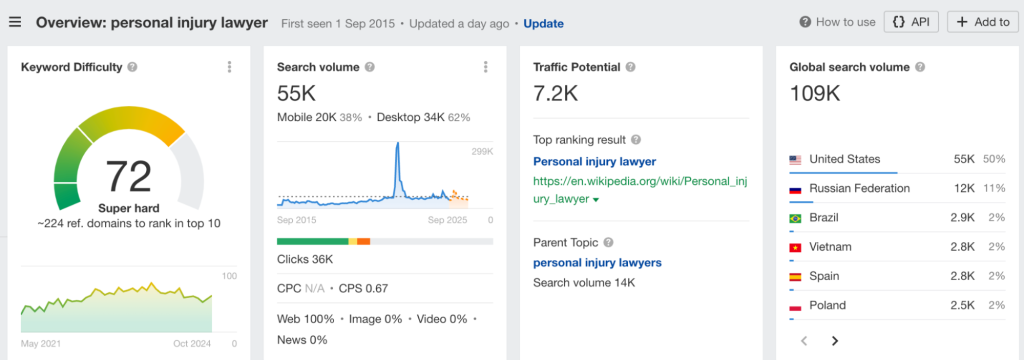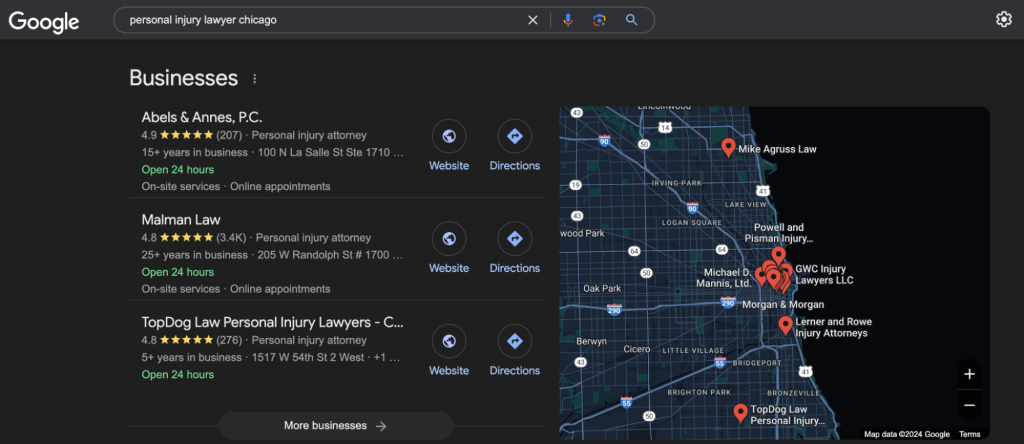
Potential clients will turn to Google when they need a personal injury lawyer. Is your firm’s website showing up in the SERPs?
This comprehensive guide dives deep into SEO strategies specifically tailored for personal injury lawyers.
Learn how to attract more clients, boost online visibility, and grow your practice with search engine optimization.
What Is SEO for Personal Injury Lawyers?
SEO (search engine optimization) for personal injury lawyers involves optimizing their firm’s website and online content to improve visibility on search engines like Google.
The goal is to rank higher for relevant keywords, such as “personal injury lawyer near me” or “car accident attorney.” This is achieved through strategies like:
➡️ Keyword research: Identifying relevant search terms potential clients use to find services like yours.
➡️ On-page SEO: Optimizing website content, titles, and meta tags to improve visibility for specific keywords.
➡️ Off-page SEO: Building external links from reputable websites to boost your site’s authority and search rankings.
➡️ Technical SEO: Ensuring your website is fast, mobile-friendly, and easy for search engines to crawl and index.
| 💡Key Point: What is the difference between organic SEO and Google Ads?
The main difference between organic search and Google Ads is how websites appear in search results. Organic search results are achieved through SEO strategies like optimizing content, keywords, and building backlinks. Being ranked highly doesn’t involve payment to Google but is earned over time through relevance and authority. Google Ads are paid listings where businesses bid on keywords to appear at the top of search results. While they provide immediate visibility, paid ads disappear once you stop paying, whereas organic results last longer but take time to build. |
Why Is SEO Important for Personal Injury Law Firms?
Most people don’t have a personal injury lawyer on speed dial. When they suddenly need one after an accident or injury, they turn to the Internet for help. Your online presence can mean the difference between securing a new client and losing them to a competitor
Think about it: someone is involved in a car accident, is shaken up, and needs legal advice quickly. What’s the first thing they do? They grab their phone and search for “car accident lawyer [their city]” or “personal injury attorney near me.”
In this critical moment, your law firm’s website appearing high up on search engine results pages is essential. The higher you rank, the more likely potential clients will click on your website.
According to Backlinko:
- The first result on Google gets over 27% of all clicks.
- The second result gets 15.8%.
- The third gets 11%.
When you reach the second page of results, the click-through rate plummets to less than 1%.
Effective SEO ensures your website appears prominently in search results, connecting you with those who need your services right when they need them. It’s about increasing your visibility, driving traffic to your website, and ultimately, attracting more clients to your firm.
The ROI for personal injury SEO speaks for itself
Why should personal injury lawyers invest time and resources into SEO? The answer is simple: the potential return on investment is substantial.
The search term “personal injury lawyer Chicago” receives about 3,200 monthly searches. If your website ranks in the first position, you should capture 27% of those clicks—about 864 per month. If 2% of these convert into clients, that’s roughly 17 new clients monthly.
If the average personal injury claim settles for $24,000, and you secure a 33-40% commission, that translates to a potential monthly income of up to $163,200! With SEO services costing around $3,000 per month, your ROI would be 5340%

Source: Ahrefs
How Google Decides Which Personal Injury Law Firm Ranks First
Google aims to provide users with the most relevant and helpful results for their search queries.
For example, when someone searches for “personal injury lawyer near me,” Google employs a complex algorithm to determine which websites deserve the top spots.
Here are the key factors that influence those rankings:
1️⃣ Relevancy
Relevancy is one of the most important ranking factors. Google matches a user’s search query with websites most relevant to their typed keywords.
For personal injury lawyers, this means optimizing your site for terms like “personal injury lawyer near me” or “car accident attorney.” The more closely your website matches the search intent, the higher your chances of ranking.
2️⃣ Content quality and freshness
Google prioritizes high-quality content that provides valuable information to users. Your website should answer common legal questions potential clients have, such as what to do after an accident or how to file a personal injury claim.
Fresh content, such as regularly updated blog posts or recent case results, signals that your website is active and relevant, which can improve your ranking.
3️⃣ Authority and backlinks
Authority is determined by the number of trustworthy websites that links back to your site. Backlinks from reputable legal directories, news outlets, or industry blogs act as “votes of confidence” for your website.
The more high-quality backlinks you have, the more Google sees your site as a credible source, improving your chances of ranking at the top.
4️⃣ Technical SEO
This refers to the behind-the-scenes elements that ensure your website is easily accessible and understandable to search engines.
Website speed, mobile friendliness, and proper site structure contribute to technical SEO success. A technically sound website allows Google to crawl and index your content effectively, improving its visibility in search results.
How to Launch Your First Personal Injury Lawyer SEO Campaign
Step 1: Know your customers
As a personal injury lawyer, you should understand your ideal client profiles (ICPs). Creating these profiles is key to focusing your marketing efforts on the right people and using your resources more effectively.
When you know who your clients are—whether they are accident victims, injured workers, or people dealing with medical malpractice—you can create campaigns that address their specific concerns and legal needs. This approach increases the likelihood of attracting the right clients and converting leads.
Identifying ICPs also helps you attract cases that match your expertise and experience, as you’ll be able to avoid wasting time and resources on prospective clients who aren’t a good fit.
Key factors to consider when identifying your ideal personal injury clients include:
✔️ Type of injury (car accidents, workplace injuries, medical malpractice).
✔️ Geographic location (areas where your firm operates).
✔️ Demographics (age, occupation, income level).
✔️ Common legal challenges (medical bills, lost wages, dealing with insurance companies).
✔️ Behavior (those who actively seek legal help or information online).
| 💡Pro-tip: Stay up to date!
Keep an eye on trends in your area. For example, if there’s a surge in medical malpractice injuries in your region, you can adjust your SEO strategy to reach individuals searching for medical malpractice lawyers. |
Step 2: Perform keyword research
Keywords are the words or phrases people type into search engines for information. For personal injury lawyers, identifying relevant keywords to target in your SEO campaign is essential for attracting potential clients.
You’ll need an SEO tool to find these keywords for personal injury SEO. Popular options include Ahrefs, SEMrush, and Moz. In this guide, we’ll use Ahrefs to help you discover the best personal injury keywords for your firm.
1️⃣ Find your seed keywords
Start by identifying key topics (hubs) related to your personal injury law practice. Consider the main areas your potential clients might need help with, such as car accidents, workplace injuries, or medical malpractice.
Use these core topics as a foundation for brainstorming initial keyword ideas.
2️⃣ Go to Keywords Explorer
In Ahrefs, navigate to the Keyword Explorer tool and input your seed keywords, such as “personal injury lawyer.”

Source: Ahrefs
3️⃣ Analyze keyword metrics

Source: Ahrefs
Your goals are to find keywords highly relevant to your personal injury law firm, attract significant traffic, and face less competition. With that in mind, review the results focusing on the following:
- Monthly search volume: The number of times a keyword is searched monthly. In the example above, we can see that the term “personal injury lawyer” gets 55,000 searches a month.
- Keyword difficulty (KD): This metric indicates how difficult it is to rank for a specific keyword. Higher difficulty means tougher competition. For “personal injury lawyer,” the KD is 72, which is hard to rank for in organic search.
- Clicks: This is the number of clicks that search results receive for that keyword. Our chosen term has 36,000 clicks a month.
- Competition in SERPs: Evaluate the competitiveness of the search engine results pages (SERPs). If major law firms or directories dominate the top spots, ranking for that keyword may be challenging.
4️⃣ Check keyword ideas
On the keyword overview page, Ahrefs suggests related keywords, questions, and long-tail keywords related to the keyword you initially searched:

Source: Ahrefs
Narrow down your options by looking into keyword difficulty, volume, or other metrics to find manageable, high-value keywords. You may uncover hidden gems in this list.
| 💡Key Point: Think Local
Most personal injury lawyers primarily serve clients in their local area. This means your SEO strategy should prioritize local search visibility. While broad keywords like “personal injury lawyer” are highly competitive, focusing on location-specific keywords can significantly improve your ranking in local searches. For example, in the screenshot below, you can see that “personal injury lawyer Chicago” has a KD of 54, a search volume of 3,20 0 per month, and a traffic potential of 1,700. This keyword is competitive, but not impossible to rank for—which is ideal for a personal injury practice in Chicago!
Source: Ahrefs |
5️⃣ Check the SERP overview
Next, do a competitor analysis by reviewing who ranks for your chosen keyword and assess whether you can compete:

Source: Ahrefs
6️⃣ Download keywords
Once you have selected a keyword in Ahrefs, you can export the list of matching terms. Under “keyword ideas,” click on “view all.”
This will take you to a detailed page with all related keywords. On the left-hand side, click “Export,” and choose to download the data in CSV format:

Source: Ahrefs
| 💡Pro-tip: Don’t have access to an SEO tool?
Don’t worry! To look for target keywords, you can use Google Keyword Planner. It’s a free tool that can help you with keyword research. |
Step 3: Set up local SEO
Local SEO entails optimizing your firm’s online presence to appear in local search results and on Google Maps when users search for a personal injury lawyer in their area.
A strong local SEO strategy is crucial for personal injury lawyers because many people search for legal help based on their location, using terms like “personal injury lawyer near me” or “car accident attorney [city].”
You must set up a Google Business Profile to appear in these local results.
Setting up this profile ensures that your law firm will feature in the Local Pack—the top three local listings that often appear above regular search results—and on Google Maps. For example, here’s what pops up when you Google “personal injury lawyer chicago”:
 Source: Google
Source: Google
How to set up Google Business for your personal injury law firm
1️⃣ Create or sign in to Your Google Account
2️⃣ Go to Google Business
3️⃣ Add or claim your business: If your law firm is already listed, claim and verify ownership. If not, click “Add your business” or “Manage now” to start the process.
4️⃣ Provide accurate and complete information, including:
- Business name
- Address
- Phone number
- Website URL
- Business category (e.g., “Personal Injury Attorney”)
- Service areas (if applicable)
- Business hours
5️⃣ Verify your business: Google will offer several verification methods, including receiving a postcard with a verification code, phone verification, or email verification (depending on your business type). Follow the instructions on your Google Business dashboard to complete the verification.
6️⃣ Optimize your listing
Once verified, enhance your Google Business Profile with:
- A compelling business description
- High-quality photos of your office and team
- Regular updates or posts about your services
- Encourage clients to leave reviews
Step 4: Sign up for lawyer-specific directories
Think of legal directories as the modern-day Yellow Pages for lawyers. These online platforms are specifically designed to connect potential clients with legal professionals. Listing your firm on these directories is a powerful way to boost your local SEO in a few ways:
✔️ Targeted audience: These directories attract individuals actively seeking legal assistance, increasing your chances of reaching potential clients.
✔️ Topical relevance: Links from lawyer-specific directories are highly relevant to your website, signaling to search engines that your site is a credible source of legal information.
✔️ Improved visibility: Directory listings increase your online presence, making it easier for potential clients looking for personal injury law firms.
| 💡Pro-tip: The top 10 legal directories
Looking for reputable legal directories to list your law firm? Look no further! Here are some of the top lawyer directories: |
Step 5: Create high-quality content
Creating high-quality content is a cornerstone of effective SEO for personal injury law firms. Remember the keyword research we discussed earlier?
By creating informative content targeting those long-tail keywords, you can attract potential injury victims actively seeking answers to their legal questions.
For example, consider the long tail keyword phrase “who pays personal injury claims car accident.” This is a common question people have after an accident, and it presents an excellent opportunity to create valuable content that draws in potential clients.
| 💡Key point: What is a “long-tail” keyword?
Long-tail keywords are longer, more specific phrases people use when searching online. They often reflect a searcher’s intent more clearly than shorter, more general keywords. Example:
Long-tail keywords tend to have lower search volume but less competition, making them easier to rank for. They also attract more qualified traffic because they target clients with specific needs. |
How to create content that ranks
✅ In-depth information: Write a comprehensive article that thoroughly answers the question. Explain possible scenarios, who might be liable, and how insurance claims work.
✅ Clear and concise language: Avoid legal jargon and present the information in a way that’s easy for everyone to understand.
✅ Engaging format: Make your content more accessible and engaging by using headings, subheadings, bullet points, and visuals.
✅ Call to action (CTA): Include a clear CTA encouraging readers to contact your firm for a free consultation at the end of your article.
ℹ️ Example: This article is a decent example of targeting this keyword. It provides relevant information but could be improved with clearer formatting, more concise language, and a stronger call to action.
| 💡Key point: Know the regulations
Before you start with content marketing for your law firm’s website, it’s crucial to understand the ethical and legal guidelines that govern law firm advertising. Your state bar association will have specific rules to ensure that all marketing materials are truthful and not misleading. Here are some key points to keep in mind:
|
Step 6: Build backlinks
Now that you’ve created high-quality content, the next step is to build links to help it rank higher for relevant search terms.
Link building involves getting other websites to link to your content, signaling to search engines that your site is relevant and trustworthy.
Below, we discuss some link-building strategies to strengthen your personal law firm’s SEO.
Create useful tools
Creating helpful tools is a great way to attract backlinks and improve your SEO. A personal injury calculator is an excellent example for personal injury lawyers.
This tool allows potential clients to estimate the value of their claims by entering details about their accidents and injuries.
For instance, the Shook and Stone Personal Injury Calculator provides an interactive way for users to understand their potential compensation. Tools like these provide value to users and encourage other websites to link to your site, improving your authority and visibility.
Sign up for Connectively (formerly HARO)
Connectively (formerly HARO) can help personal injury attorneys obtain backlinks by connecting them with journalists and bloggers who need expert legal insights for their articles.
By signing up for Connectively, lawyers can respond to queries related to personal injury law, offering quotes or expert opinions. When their insights are used in an article, the publication often provides a backlink to the lawyer’s website.
For example, a query like the one below asks legal professionals about the importance of medical record reviews in personal injury and malpractice cases:

Source: Connectively
To use Connectively, follow these steps:
- Sign up for a free account at Connectively as a source.
- Choose your preferences for the queries you’d like to receive, such as legal or personal injury topics.
- Review daily emails with media queries from journalists and bloggers.
- Respond to relevant queries by clicking “pitch” and offering expert insights or opinions, including your credentials and website.
Write a guest post
Guest posting involves writing and publishing articles on industry-related websites. It’s a valuable strategy a personal injury lawyer can implement to build authority and generate backlinks to their website.
Aside from building links, guest posting offers other key advantages:
✔️Exposure to a new audience: Guest posting allows you to reach a broader audience that may not have discovered your firm otherwise.
✔️Brand building: By contributing valuable content to other platforms, you establish your firm as a thought leader in personal injury law.
How do you find guest posting opportunities?
- Identifying relevant blogs: Use search operators like “personal injury lawyer” + “write for us,” “legal blog” + “guest post,” or “submit a guest post” + “personal injury law” to find sites actively accepting guest posts.
- Contact connections: Contact fellow attorneys or industry professionals to ask whether they accept guest content.
- Hire a guest posting service: Services like Authority Builders can help you find high-quality guest posting opportunities on reputable sites.
- Research: Explore legal sites like Enjuris to find personal injury law guest post opportunities.
Answer questions on forums
People frequently ask legal questions on forums, making them a great place for personal injury lawyers to engage with potential clients. Take this example from Justia:

Source: Justia
While some debate whether directory links hold SEO value, participating in relevant discussions is still worthwhile. It helps boost brand awareness and lets you connect with people seeking legal help.
Forum posting best practices
✅ Build credibility first: Set up a complete and professional account. Start by participating in discussions, answering legal questions, and interacting with other users without dropping links.
✅ Be helpful: Focus on answering questions thoroughly and offering relevant legal insights. Avoid self-promotion in the beginning.
✅ Earn the right to share links: After you’ve established yourself as a helpful forum member, begin including links to your content where it genuinely adds value. Ensure your links are integrated naturally within your responses, offering further resources to help users.
Tighten up your technical SEO
Now that you’ve mastered keyword research, content creation, and building some backlinks, the next step in your personal injury lawyer SEO strategy is technical SEO.
This ensures your law firm website has a solid technical foundation so search engines like Google can easily access, understand, and rank your content.
Here are key technical aspects to focus on:
Accessibility and indexing
➡️ Robots.txt: This file allows you to control which parts of your website search engines can or cannot crawl. For example, you can block nonpublic or sensitive areas of your site from being accessed by search bots.
➡️ No-index tags: These prevent specific pages from being indexed by search engines, like thank-you or admin pages that aren’t relevant for ranking.
➡️ Canonical tags: Canonical tags are useful when you have multiple versions of a page. They tell search engines which version is the primary one, helping to avoid duplicate content issues.
➡️ XML sitemap: This acts like a roadmap for search engines, guiding them to the most important pages on your site, ensuring quicker and more efficient indexing.
Crawling
Use tools like Screaming Frog to monitor how well Google’s bots navigate your personal injury law firm’s site and fix broken links or errors.
Site speed
Fast-loading pages improve both user experience and SEO. Compress images, minimize scripts, and use tools like Google PageSpeed Insights to ensure your site loads within 3 seconds.
Implement schema markup
Schema markup is code you add to your website to help search engines understand your content. Think of it as providing labels and descriptions for the different elements on your website, like your law firm’s address and phone number, the types of legal services you offer, and information about your lawyers.
This extra information helps search engines display your website in more relevant search results. It can also help your firm appear in “rich snippets,” which are enhanced search results with additional information like reviews and business hours. Here is an example of this type of structured data:

Source: Google
ℹ️ Here is a guide on how to implement structured data.
Security
Ensure your site uses HTTPS encryption, a ranking factor for Google that helps protect user data.
ℹ️ Here is a guide on implementing HTTPS encryption on your website.
Site architecture
Organize your content with clear categories and subcategories to make it easier for users and search engines to find information.
The main goal here is to ensure that a potential client can find what they are looking for.
Improve your on-page SEO
On-page SEO refers to optimizing individual pages on your website to improve search engine rankings and drive more relevant traffic. For personal injury firms, key elements include:
➡️ Title tags: The title tag is the clickable headline that appears in search engine results and at the top of your browser tab. It should include your main keyword and briefly describe the page’s content, typically within 60 characters.
➡️ Meta descriptions: These are short summaries (under 160 characters) of pages’ content that appear beneath the titles in search results. They are meant to entice users to click on your link by giving them a preview of what to expect.
➡️ Header tags (H1, H2, etc.): Header tags structure your content by breaking it into sections. The H1 tag is used for the main heading, and H2, H3, etc., are used for subheadings. These help search engines understand the hierarchy and organization of your content.
➡️ Keyword placement: Incorporate keywords naturally throughout your content, focusing on headers, the introduction, and the conclusion.
➡️ Internal linking: Connect related pages within your website through internal links. For example, link a blog post on car accidents to your main personal injury page to enhance navigation and help search engines understand your site’s structure.
➡️ Image optimization: Optimize images using descriptive file names and alt text that include keywords. This helps search engines understand image content and boosts accessibility for visually impaired users.
Monitor results
To track the effectiveness of your SEO efforts, use these tools to regularly monitor critical metrics:
📈Google Analytics: Use it to track website traffic, user behavior, and conversion rates. It helps you understand where visitors come from and how they interact with your site.
📈Google Search Console: This tool shows your site’s performance in search results, tracks keyword rankings, and highlights any indexing or technical issues.
📈Ahrefs: Ahrefs provides insights into your backlink profile, keyword rankings, and overall site health, helping you identify opportunities for improvement.
Final Thoughts: Personal Injury Lawyer SEO
SEO is difficult and time-consuming if you’re opting to do it yourself, and hiring an in-house marketing team can be expensive. While freelancers are an option, quality results are by no means guaranteed.
The best choice is to work with an agency like Authority Builders. We offer tailored link-building and SEO services to ensure your website ranks higher and attracts more clients.
With our expertise, you can focus on growing your law firm while we handle the rest. Reach out to Authority Builders today to get started!
